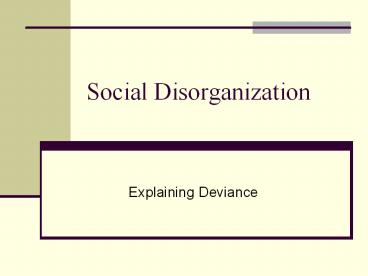Social Disorganization Explaining Deviance Social PowerPoint PPT Presentation
Title: Social Disorganization Explaining Deviance Social
1
Social Disorganization
- Explaining Deviance
2
Social Disorganization Perspective
- The perspective views society as a complex
dynamic social system whose parts are
coordinated. - Change in one part of the system, requires
adjustment in other parts. - Social disorganization refers to lack of
adjustment or poor adjustment between the parts.
3
A Definition
- Social disorganization is conceived of a failure
of rules. - There are three types of disorganization
- Normlessness
- Culture Conflict
- Breakdown
4
Types of Social Disorganization
- Normlessness no rules exist on how to act.
- Culture Conflict at least two opposing sets of
rules exist on how to act. Acting on one set may
violate other expectations. - Breakdown is a violation on this same theme.
Rules exist, but conformity fails to produce
promised rewards or yields punishment instead.
5
Causes of Social Disorder
- Social change broadly speaking is the cause of
social disorder. - Change causes the components of the social system
to get out of tune with each other. - Technical, demographic or cultural changes are
the immediate conditions of social change.
6
Consequences of Social Change
- From Personal Perspective
- Personal Stress resulting in
- Personal disorganization mental illness,
alcoholism - From Organizational Perspective
- Change in the system
- Continues to function as is
- System breakdowns
7
Solutions
- Define problem
- Parts of the system that are out of order can be
brought back into equilibrium.
8
Differences between
- Social Disorganization
- Studied problems by examining rules
- Used their own language and conceptualization
- Focused on scientific theory and methods
- Focused on the acquisition of knowledge rather
than solutions
- Social Pathology
- Failings of Individuals Institution
- Used language from other sciences
- More philosophical than scientific
- Wanted to apply discoveries to social problems
PowerShow.com is a leading presentation sharing website. It has millions of presentations already uploaded and available with 1,000s more being uploaded by its users every day. Whatever your area of interest, here you’ll be able to find and view presentations you’ll love and possibly download. And, best of all, it is completely free and easy to use.
You might even have a presentation you’d like to share with others. If so, just upload it to PowerShow.com. We’ll convert it to an HTML5 slideshow that includes all the media types you’ve already added: audio, video, music, pictures, animations and transition effects. Then you can share it with your target audience as well as PowerShow.com’s millions of monthly visitors. And, again, it’s all free.
About the Developers
PowerShow.com is brought to you by CrystalGraphics, the award-winning developer and market-leading publisher of rich-media enhancement products for presentations. Our product offerings include millions of PowerPoint templates, diagrams, animated 3D characters and more.

